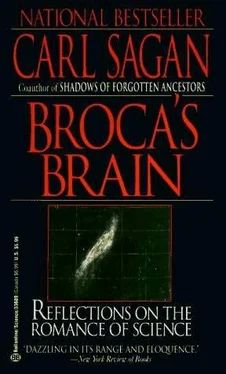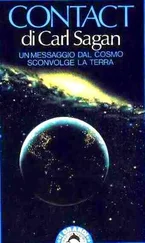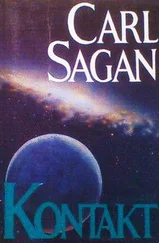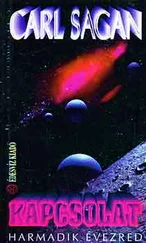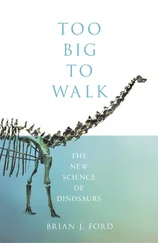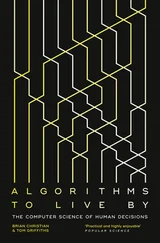Carl Sagan - Broca's Brain - The Romance of Science
Здесь есть возможность читать онлайн «Carl Sagan - Broca's Brain - The Romance of Science» весь текст электронной книги совершенно бесплатно (целиком полную версию без сокращений). В некоторых случаях можно слушать аудио, скачать через торрент в формате fb2 и присутствует краткое содержание. Жанр: Физика, на английском языке. Описание произведения, (предисловие) а так же отзывы посетителей доступны на портале библиотеки ЛибКат.
- Название:Broca's Brain: The Romance of Science
- Автор:
- Жанр:
- Год:неизвестен
- ISBN:нет данных
- Рейтинг книги:3 / 5. Голосов: 1
-
Избранное:Добавить в избранное
- Отзывы:
-
Ваша оценка:
- 60
- 1
- 2
- 3
- 4
- 5
Broca's Brain: The Romance of Science: краткое содержание, описание и аннотация
Предлагаем к чтению аннотацию, описание, краткое содержание или предисловие (зависит от того, что написал сам автор книги «Broca's Brain: The Romance of Science»). Если вы не нашли необходимую информацию о книге — напишите в комментариях, мы постараемся отыскать её.
Broca's Brain: The Romance of Science — читать онлайн бесплатно полную книгу (весь текст) целиком
Ниже представлен текст книги, разбитый по страницам. Система сохранения места последней прочитанной страницы, позволяет с удобством читать онлайн бесплатно книгу «Broca's Brain: The Romance of Science», без необходимости каждый раз заново искать на чём Вы остановились. Поставьте закладку, и сможете в любой момент перейти на страницу, на которой закончили чтение.
Интервал:
Закладка:
Both Abbott and Hale were solar physicists, and it seems clear that both had been captured by the young Goddard’s vision of a rocket sailing free above the obscuring blanket of the Earth’s atmosphere, able to view the Sun and stars unimpeded. But Goddard soared far beyond this daring vision. He talked and wrote of experiments on the composition and circulation of the upper atmosphere of the Earth, of performing gammaray and ultraviolet observations of the Sun and stars from above the Earth’s atmosphere. He conceived of a space vehicle passing 1,000 miles above the surface of Mars-by a curious historical accident just the low point in the orbits of the Mariner 9 and Viking spacecraft. Goddard calculated that a reasonably sized telescope at such a vantage point would be able to photograph features tens of meters across on the surface of the Red Planet, which is the resolution of the Viking orbiter cameras. He conceived of slow interstellar flight at velocities and time scales just equivalent to that of the Pioneer 10 and 11 spacecraft, our first interstellar emissaries.
Goddard’s spirit soared higher still. He conceived, not casually but quite seriously, of solar-powered spacecraft, and in a time when any practical application of nuclear energy was publicly ridiculed, nuclear propulsion for spacecraft over vast interstellar distances. Goddard imagined a time in the far distant future when the Sun has grown cold and the solar system become uninhabitable, when manned interstellar spacecraft would be outfitted by our remote descendants, to visit the stars-not merely the nearby stars, but also remote star clusters in the Milky Way Galaxy. He could not imagine relativistic spaceflight and so hypothesized a method of suspended animation of the human crew or-even more imaginative-a means of sending the genetic material of human beings which would automatically, at some very distant time, be allowed to recombine and produce a new generation of people.
“With each expedition,” he wrote, “there should be taken all the knowledge, literature, art (in a condensed form), and description of tools, appliances, and processes, in as condensed, light, and indestructible a form as possible, so that the new civilization could begin where the old ended.” These final speculations, entitled “The Last Migration,” were sealed in an envelope with instructions to be read “only by an optimist.” And that he surely was-not a Pollyanna who chooses to ignore the problems and evils of our times, but rather, a man committed to the improvement of the human condition and the creation of a vast prospect for the future of our species.
Goddard’s dedication to Mars was never far from his mind. In the wake of one of his first experimental successes, he was induced to write a press release on the details of his launch and its ultimate significance. He wished to discuss spacecraft to Mars but was dissuaded on the ground that this was too fantastic. As a compromise he talked about sending a quantity of magnesium flash powder which would make a visible bright flare on the Moon when it landed. This caused a sensation in the press. Goddard was for many years after disparagingly referred to as “the Moon Man,” and he remained rueful about his relations with the press ever after. (An editorial in the New York Times which criticized Goddard for having “forgotten” that a rocket will not work in the vacuum of space because it has nothing to push against may have contributed to his unease. The Times discovered Newton’s third law of motion and retracted its error only in the age of Apollo.) Goddard mused: “From that day, the whole thing was summed up, in the public mind, in the words ‘moon rocket’; and thus it happened that in trying to minimize the sensational side, I had really made more of a stir than if I had discussed transportation to Mars, which would probably have been considered as ridiculous by the press representative and doubtless never mentioned.”
Goddard’s notebooks are not filled with psychological insights. That was not, at least not very much, the spirit of the times in which he lived. [14]But there is a remark in Goddard’s notebooks that can be only a flash of poignant self-insight: “God pity a one-dream man.” That surely is what Goddard was. He knew great satisfaction in seeing the advances in rocket technology, but it must have been agonizingly slow. There are so many letters from Abbott urging faster progress, and so many responses from Goddard citing practical impediments. Goddard never lived to see the beginning of rocket astronomy and high-altitude meteorology, much less flights to the Moon or planets.
But all these things are happening because of what are very clearly the technological fruits of Goddard’s genius. October 19, 1976, was the 77th Anniversary Day of the Martian vision of Robert H. Goddard. On that day there were two functioning orbiters and two working landers on Mars, the Viking spacecraft whose origins can be traced with utter confidence back to a boy in a cherry tree in a New England autumn in 1899. Among its many other objectives, Viking had the task of checking out the possibility of life on Mars, the prospect that was so powerful a motivation for Goddard so many years before. Curiously, we are still not sure what the Viking biology results mean. Some think that microbial life may have been discovered; others think it unlikely. It is clear that a major program of future exploration of Mars will be required to understand just where in cosmic evolution this neighboring world lies and what its connection is with the state of evolution on our own planet.
From its earliest stages, rocket technology developed because of an interest in life on other worlds. And now that we have landed on Mars, obtained tantalizing and enigmatic biological results, the follow-on missions-roving vehicles and returned sample canisters-in turn require further developments in spacecraft technology, a mutual causality that I think Goddard would have appreciated.
CHAPTER 19

We ever long for visions of beauty,
We ever dream of unknown worlds.
MAXIM GORKY
UNTIL RELATIVELY recently, astronomy suffered from a serious impediment and remarkable peculiarity: it was the only thoroughly nonexperimental science. The materials of study were all up there, and we and our machines were all down here.
No other science was so severely constrained. In physics and chemistry, of course, all is forged on the anvil of experiment, and those who doubt a given conclusion are free to perform a wide range of alternative manipulations of matter and energy in an attempt to extract contradictions or alternative explanations. Evolutionary biologists, even those of very patient temperaments, cannot afford to wait a few million years to observe one species evolve into another. But experiments on common amino acid sequences, enzyme structure, nucleic acid codes, chromosomal banding, and anatomy, physiology and behavior make a compelling case for the fact that evolution has occurred and clearly show which plant or animal groups (such as human beings) are related to which others (such as the great apes).
It is true that geophysicists, studying the deep interior of the Earth, cannot travel to the Wiechert discontinuity between core and mantle, or (just yet) to the Mohorovicic discontinuity between mantle and crust. But batholiths, extruded from the deep interior, can be found here and there on the surface and examined. The geophysicists have relied largely on seismic data, and here, like astronomers, they could not force the favors of nature but were compelled to await their voluntary bestowal-for example, in a seismic event situated on the other side of the Earth so that one of two nearby seismometers would be in the shadow of the Earth’s core and the other not. But impatient seismologists can and have set off their own chemical and nuclear explosions to ring Earth like a bell. And there are intriguing recent hints that it may be possible to turn earthquakes on and off. Those geologists intolerant of inferential reasoning could always go to the field and examine contemporary erosion processes. But there was no exact astronomical equivalent of the hard-rock geologist.
Читать дальшеИнтервал:
Закладка:
Похожие книги на «Broca's Brain: The Romance of Science»
Представляем Вашему вниманию похожие книги на «Broca's Brain: The Romance of Science» списком для выбора. Мы отобрали схожую по названию и смыслу литературу в надежде предоставить читателям больше вариантов отыскать новые, интересные, ещё непрочитанные произведения.
Обсуждение, отзывы о книге «Broca's Brain: The Romance of Science» и просто собственные мнения читателей. Оставьте ваши комментарии, напишите, что Вы думаете о произведении, его смысле или главных героях. Укажите что конкретно понравилось, а что нет, и почему Вы так считаете.
